ISSN ONLINE(2319-8753)PRINT(2347-6710)
ISSN ONLINE(2319-8753)PRINT(2347-6710)
Sanaur Rehman1, Khalid Zaidi2, Mahir Husain3
|
| Related article at Pubmed, Scholar Google |
Visit for more related articles at International Journal of Innovative Research in Science, Engineering and Technology
The test bed for the HSDI diesel engine is developed in this study. Also in this study the energy balance on the HSDI diesel engine is done. Energy balance is done at various speeds of the engine. Performance parameters of the engine are calculated on the test bed at various speeds. Calibration of the flowmeters (orificemeter and turboflowmeter) is done in this study. It is found that coolant losses and exhaust losses are high at low loads and other losses like radiative losses are high at high loads. Brake power increases with loads increase in load on the engine. Coolant losses as well as exhaust losses are high at low engine speed and they are small at high engine speed.
Keywords |
| HSDI diesel engine, energy balance, test bed, performance parameters, energy losses |
INTRODUCTION |
| A. Direct Injection (DI) Diesel Engine |
| In diesel engine air is drawn into the cylinder during the suction stroke and compressed to a very high pressure, thus raising the air temperature to a value required to ignite the fuel injected into the cylinder. The usual compression ratios vary from 12:1 to 20:1. [1]In direct injection diesel engine, the fuel is injected into a combustion chamber directly above the piston crown. The combustion chamber design is of open chamber (the disc hemisphere and bowl in piston), which puts most of the clearance volume into a compact space. In medium duty truck diesel engine, it is often necessary to use a swirling air flow rotating about the axis of cylinder, which is created by the suitable design of inlet port and valve, to achieve fuel air mixing and fuel burning rates. The fuel injection nozzle is multihole nozzle, typically with three to five holes. [2] |
| B. Indirect Injection (ID) Diesel Engine |
| The smaller diesel engine operate at higher speed the larger diesel engines, hence the time available for mixing the fuel is less and fuel injection and combustion system must achieve faster fuel-air mixing rates. Fuel is injected into this highly turbulent and often rapidly swirling flow in this auxiliary or pre chamber and very high mixing rates are achieved. Combustion starts in the pre chamber, and the resulting pressure rise in the pre chamber forces burning gases, fuel, and air into the main chamber. Since this outflow is extremely vigorous, rapid mixing then occurs in the main chamber as the burning jet mixes with the remaining air and combustion completed. [2] |
EXPERIMENTAL SET UP |
| A. Experimental Set Up |
| The experimental set up for the diesel engine test bed comprises of the following components: |
| • Swaraj Mazda 4-stroke Direct Injection Turbocharger Intercooled Diesel Engine. |
| • Hydraulic Dynamometer |
| • Air Box |
| • Crank Angle Disc |
| • Fuel Tank |
| • Temperature Sensors |
| The above components of diesel engine test bed are shown in the schematic diagram in Fig. 1.1. |
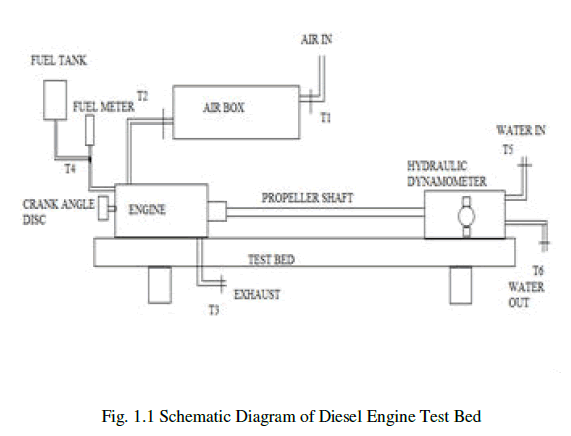 |
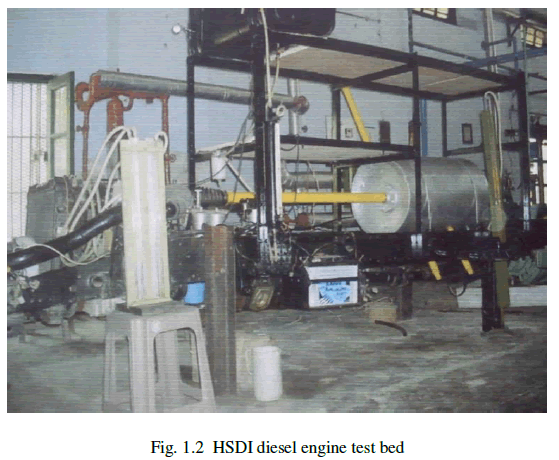 |
| 1) Dynamometer: The hydraulic dynamometer is used in the present study as shown in the Figure.1.3. A dynamometer is used to measure the load on the engine. The dynamometer absorbs the power developed by the prime mover. Thepower absorbed by the dynamometer must be dissipated to the ambient air or transferred to cooling water. |
| Specification of dynamometer |
| Maximum Torque = 20 Kg-m |
| Maximum Speed = 3000 rpm |
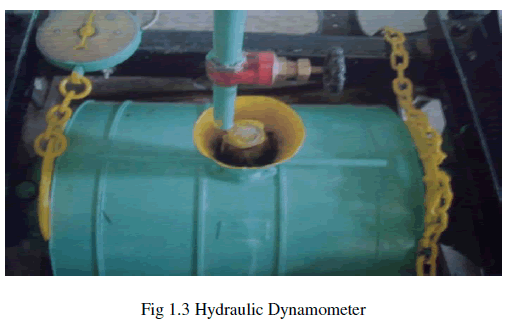 |
| 2) Temperature Sensors:Temperature is most efficiently measured by means of thermocouple. The thermocouple used in the present study is chromel-alumel type ( K-type). Operating range of chromel-alumel thermocouple is from 0áôüF to 2300áôüF. [3] |
| There are five thermocouples mounted as follows |
| ïÃâ÷ For measuring the inlet coolant temperature. |
| ïÃâ÷ For measuring the outlet coolant temperature. |
| ïÃâ÷ For measuring the exhaust gas temperature. |
| ïÃâ÷ For measuring the inlet air temperature after turbocharged |
| ïÃâ÷ For measuring inlet air temperature before turbocharged. |
| 3) Fuel tank:There are two fuel tanks, one is of larger diameter and the other one is of smaller diameter. Both the tanks are attached with a glass tube parallel to it from the bottom end. The diameter of glass tube is 6 mm and the diameter of fuel tank is 72 mm. |
| 4) Crank Angle Disc:It is a cast iron disc of 8 inch in diameter mounted on the engine shaft. Three holes of appropriate diameter being 30 degree apart from each other made on the disc. The centre slot represents the TDC of the engine. The slot ahead of the central slot represents the advance and the one to the right represent the 30 degree after TDC. |
CALIBRATION |
| A. Calibration |
| The calibration of all instruments is instrument against a known standard subsequently to reduce error in accuracy. Calibration procedures involve a comparison of the particular instrument with either (1) a primary standard, (2) a secondary standard with a higher accuracy than the instrument to be calibrated or (3) a known input source. [3] |
| B. Flow meters |
| Flow meters are used to measure the discharge of any fluid. Many research projects and industrial processes depend on a measurement of fluid flow to furnish important data for analysis. Flow rate measurement devices frequently require accurate pressure and temperature measurements in order to calculate the output of the instrument. The working principle involves placing a fixed area flow restriction of some type in pipe or duct carrying fluid. The flow restriction causes pressure drop which varies with flow rate. Thus measurement pressure pickup allows flow rate measurements [4]. |
| 1) Turbulent flow meters: Turbulent flowmeter is shown in the Figure 1.4 given below. Very often when flow rate is high, a turbulent flow meters is also preferred because of the smaller size and compact design when turbulent flow meter is used the pressure variation in the pipe flow of the fluid with the length of the pipe can be design as |
| ΔP/L = 0.5*ρ*V 2*(λ/d) (1) |
| For Reynolds number between 400 and 100000, the Blasius equation gives a good approximation: |
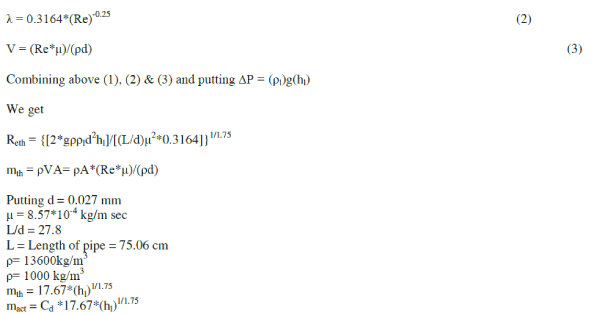 |
| Where Cd is the Coefficient of discharge |
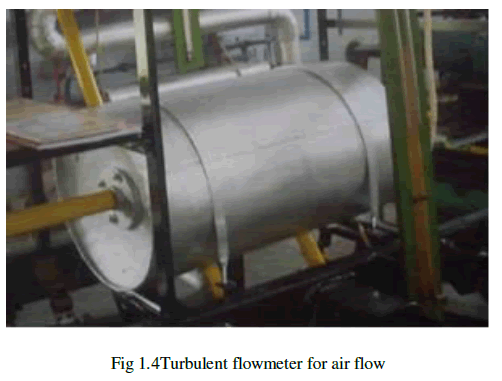 |
| 2) Orificemeter |
| Orificemeter is an obstruction flow device. It is used for the measurement of mass flow rate of the coolant flow on the diesel engine test bed as shown in the Fig. 1.5. |
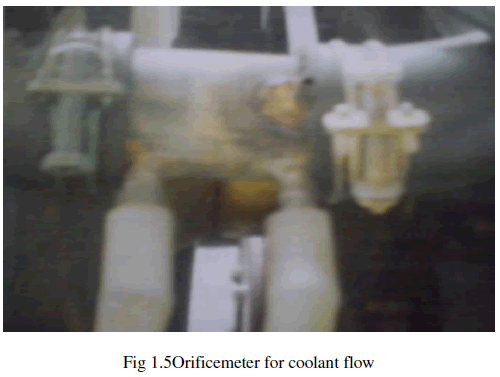 |
| Calibration of the orificemeter is done in the following way. We have the relation for volumetric flow rate of coolant as |
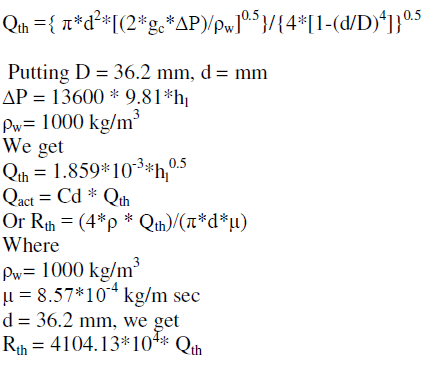 |
PERFORMANCE PARAMETERS |
| Basic engine performance parameters are the following: |
| A. Brake Power |
| The power developed by the engine at the shaft is called brake power (BP) and is given as |
| BP = (2*π*N*T/60) |
| Where measurement of brake power involve the determination of torque and the angular speed of the output shaft. The torque measurement device is the hydraulic dynamometer. The speed of output shaft is measured with the help of mechanical tachometer. |
| B. Measurement of temperatures |
| In this experiment temperature indicators are used for measuring the temperatures at different locations as shown in the Fig. 1.6 given below. |
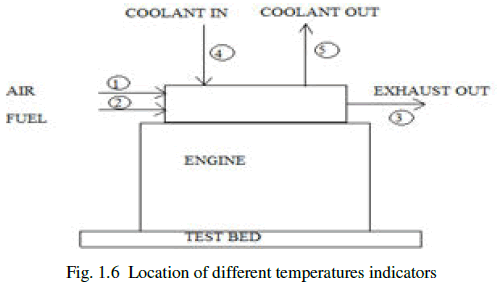 |
| C. Measurement of fuel flow rate |
| There are two fuel tanks, one is of larger diameter and the other one is of smaller diameter. Both the tanks are attached with a glass tube parallel to it from the bottom end. A scale is kept to measure the fuel level in the glass tube hence in the fuel tank. Fuel starts falling in both the tanks and hence in the glass tube. The fall in the level of fuel in the can be measured with the help of the scale and time is noted for definite fall of level. By knowing the diameter of the fuel tank and the glass tube one can know the fuel consumption per unit time. Mass flow rate of fuel is given as Mf = (area of tank*density of fuel*length of liquid fall)/time |
| D. Measurement of Air flow rate |
| Air flow rate is measured with the help of turbulent flow meter. Air flow rate is given as |
 |
ENERGY BALANCE |
| A. Heat released from the combustion of fuel is given as |
| Qf = Mass flow rate of fuel * Lower calorific value of fuel |
| B. Heat gained by coolant is given as |
| Qc= Mass flow rate of coolant*sp heat*temp difference |
| C. Heat carried away by exhaust is given as |
| Qe = mass flow rate of exhaust* sp heat*temp difference |
| D. Brake power available is given as |
| BP = (2*π*N*T/60) |
RESULT AND DISCUSSION |
| A. Graphs for results obtained when engine running at 1500 rpm |
| In the CI engine, at high load owing to the increased fuel wastes, higher fuel-air ratios are required. At constant speeds with increase in load on engine the fuel consumption increases since the air supply is almostconstant at constantspeed of engine therefore the air-fuel ratio decreases with load on engine as shown in the Fig. 1.10 and Fig. 1.14. |
| Since the CI engines are quality governed engines i.e., with increase in load on the engine, the air supply remains constant but the fuel supply changes and it increase with load on the CI engine [5] and this can be explained by the Fig.1.7 and Fig. 1.11 at both speeds. |
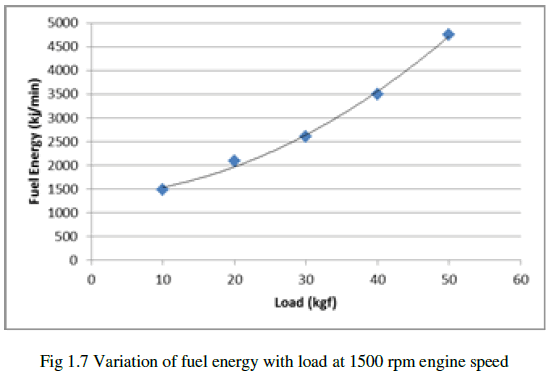 |
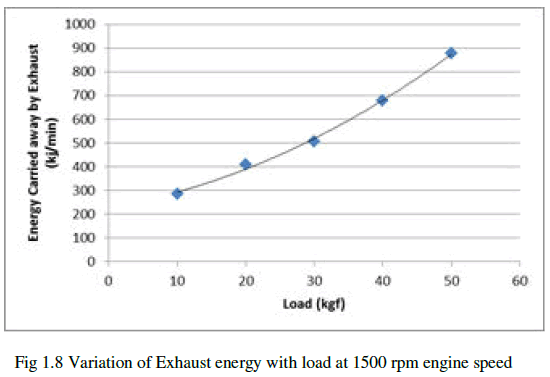 |
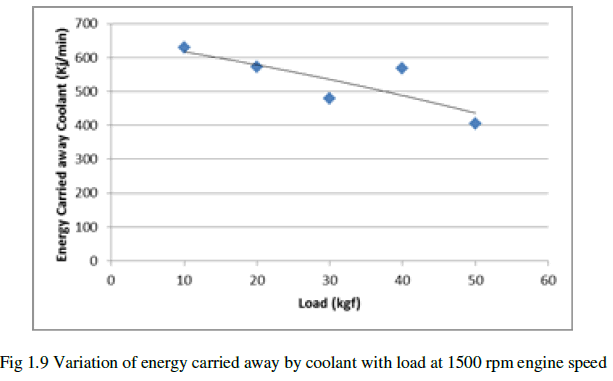 |
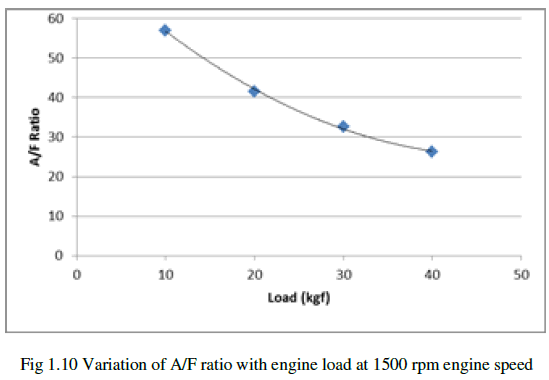 |
| B. Graphs for results obtained when engine running at 2500 rpm |
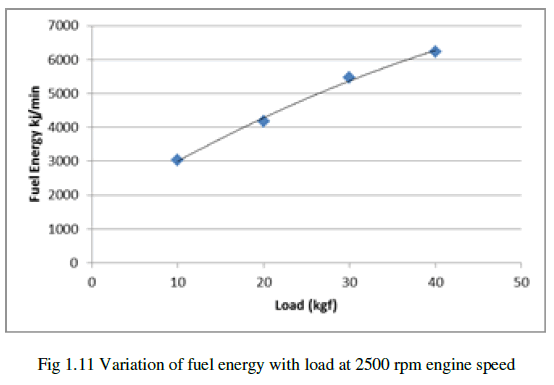 |
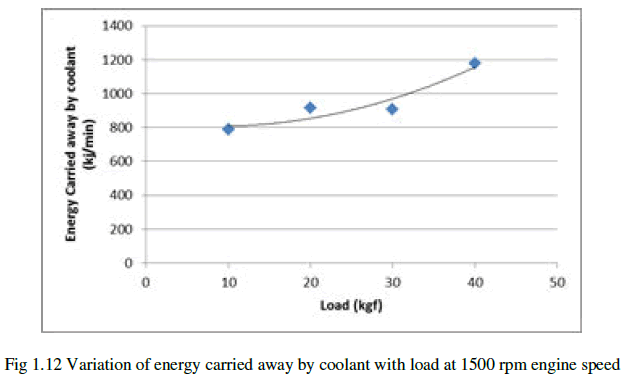 |
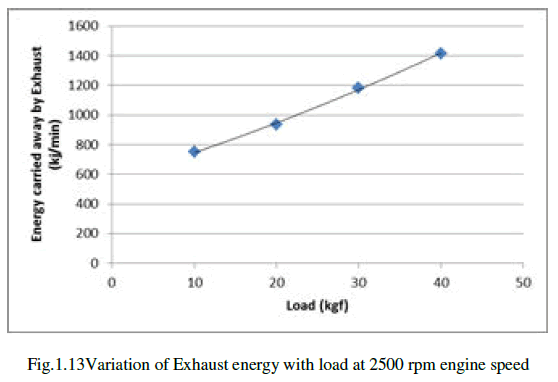 |
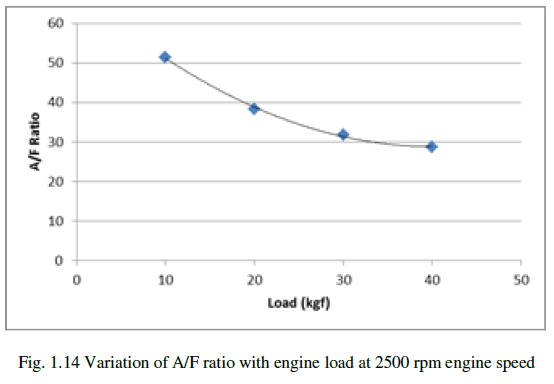 |
| C. Energy or Heat Balance Graphs |
| The energy balance within an engine is very complicated. The energy input to the engine goes out in various forms- a part in the form of brake power output, a part goes into exhaust and the rest is taken by the cooling water and lubricating oil. The breakup of fuel energy into these different parts is called heat balance. A substantial part of the friction power (about half) is dissipated between the piston and piston rings and cylinder wall and is transferred as thermal energy to the cooling medium. The remainder of the friction power is dissipated in the bearing, valve mechanism, or drives auxiliary devices and is transferred as thermal energy to the surrounding environment. The heat carried away by the cooling medium consists of heat transferred to the combustion chamber walls from the gases in the cylinder, heat transferred to the exhaust valves and port in the exhaust process. [6] |
| The coolant loss is more at low loads and radiation loss is high at high loads as shown in the Fig. 1.15 andFig. 1.16. given below. The exhaust losses are also decreases with increase in load on the engine. The bmep, b.p and torque directly increase with load as shown in figures given below. Unlike the SI engine b.p and bmep are continuously rising curve and are limited only by the smoke. The exhaust temperature is also nearly proportional to the load. Since the efficiency of the CI engine is more than SI engine, the total losses are less in case of CI engine. |
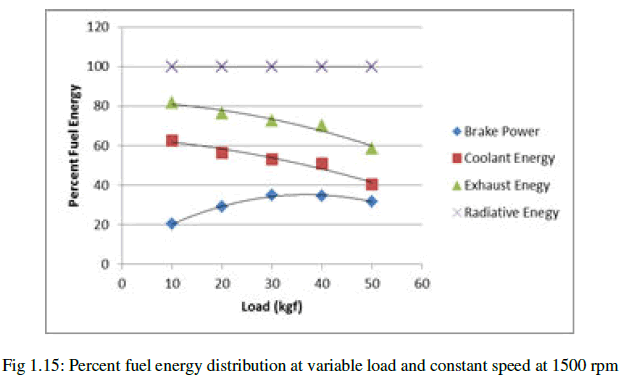 |
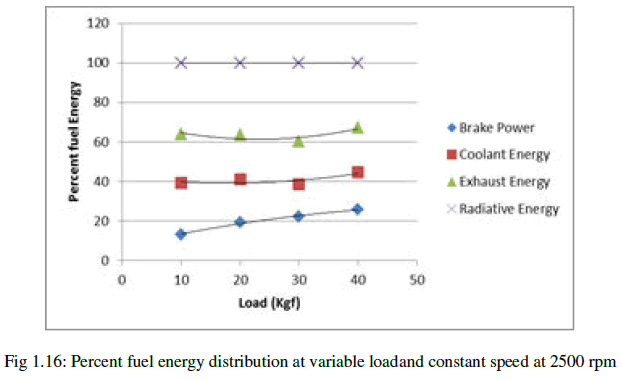 |
CONCLUSION |
| In the present study heat or energy balance is done on a four stroke four cylinder turbocharged intercooled DI diesel engine test bed. Energy balance is done at various speeds of the engine. Performance parameters of the engine are calculated on the test bed at various speeds. Calibration of the flowmeters (orificemeter and turboflowmeter) is done in the present study. It is found that coolant losses and exhaust losses are high at low loads and other losses like radiative losses are high at high loads. Brake power increases with increase in load on the engine. Coolant losses as well as exhaust losses are high at low engine speed and they are small at high engine speed. |
ACKNOWLEDGMENT |
| We have a great pleasure in expressing our deep sense of gratitude and indebtedness toProf.Khalid Zaidi, Department of Mechanical Engineering, Aligarh Muslim University, Aligarh. We would like to thank him for his esteemed guidance, encouragement and valuable advice during this paper work. |
References |
|